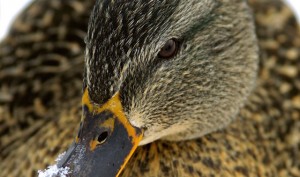The first cold blast from Canada has settled in the upper Mississippi and Central Flyways. While the system was not the usual early November blizzard that moves ducks in mass, migration activity has picked up significantly in the northern portions of the flyway as ducks are compressed along the early freeze line, creating excellent hunting opportunity in the northern states.
Hello folks, and, as always, welcome to Waterfowler.com.
The second week of November traditionally brings the first hard freezes to the north and a Clipper system that moves ducks in mass. Holding to weather tradition the first cold front arrived and ducks have moved. Just over a week ago the mid-continental mallard population was strung out from unfrozen waters in Canada to the Gulf Coast – seemingly everywhere and nowhere all at once in any great concentration.
Continued icy temperatures in Canada the U.S. Prairie Pothole region have compacted the northern edge of the migration into the upper third of the nation. Mallard numbers are near peak along the river corridors of the north – from the Missouri and Mississippi to the Platte and the Snake.
Diver activity in the Great Lakes Region has increased significantly as the cold front fueled the calendar movements of Canvasback, Scaup and Goldeneye – with increased of white-winged scoter and long-tailed ducks from Green Bay to the western basin of Lake Erie.
As expected, the drought continues to have a negative impact the season. Hunter participation is expected to reach epic lows in a season that recorded the highest level of breeding ducks since counting began.
As predicted earlier in the season, field hunters in the upper parts of the flyways are experiencing above average success in many areas. While larger, deeper impoundments are holding record numbers of birds, the depth and lack of forage has resulted in increased field feeding activity. For the small marsh hunter facing drought stricken “honey holes” there are alternatives to salvage your season – and perhaps, make it be better than most.
If you have never had the opportunity to hunt under a tornado of field feeding mallards, now is the season to expand your arsenal of knowledge and tactics. Focus on gaining access to fields near large bodies of water. Keep in mind that wind direction will play a significant role in the direction waterfowl move when searching for food and know a change of winds can mean the difference between seeing a few birds and more than you could have imagined.
As the saying goes, “when the going gets tough, the tough go hunting.” Before you write off your season early, commit to shelving tradition and trying something new.
PACIFIC FLYWAY:
Duck numbers increased significantly in the northern portion of the flyway, with mallard numbers good to excellent in Montana, Idaho and northwestern Wyoming. In Washington and Oregon, mallard numbers increased along with the divers over the past week and hunting has improved. Hunter success in northern California remains below average for this time of year with gadwall and teal providing the best opportunity in many areas. Duck numbers in Utah are good to excellent at this time with gadwall, widgeon, teal and other early migrators providing a healthy mixed bag. In southern California, teal numbers are good to excellent and filling the most slots in the daily bag.
CENTRAL FLYWAY:
Mallard and snow goose activity reached excellent levels of the past week in the Dakotas, Colorado and northern Nebraska. Early migrating ducks continued to push south through drought stricken areas Nebraska, Kansas and Oklahoma towards the gulf. Despite weather conditions that would normally allow birds to stack and hold in these areas, the drought and hunting pressure are keeping birds moving in a here today and gone tomorrow fashion. Scout hard and hunt often for the best success. Hunting in Texas is good to excellent form the Panhandle to the Gulf coast – with all species providing mixed bag.
MISSISSIPPI FLYWAY:
Mallard and Canada goose numbers are nearing peak levels in Minnesota and Wisconsin at this time. Divers numbers increased significantly over previous weeks as they have begun their push across the Great Lakes. Early migrating ducks continue to push through drought stricken areas in Illinois, Iowa and Indiana with mallard numbers up over previous weeks. Gadwall, teal, pintail and widgeon are good to excellent from Missouri to the Gulf coast.
ATLANTIC FLYWAY:
In the aftermath of Hurricane Sandy, displaced birds are returning to coastal areas devastated by the storm. Waterfowler.com encourages our members to make a contribution to the recovery efforts by supporting the Red Cross during this time of need. Waterfowler.com would like to extend our wishes for a speedy recovery to members and all residents in the path of the hurricane.
Seaduck numbers are good to excellent at this time Maine to New York with mallard and black duck numbers on the rise. Mallard and goose numbers are slightly above average for this time of year from eastern Pennsylvania to Maryland. Wood ducks and teal have moved south into the Carolinas along with other early migrating ducks. Ring-neck duck numbers are slightly above average for this time of year from Georgia to Florida, with teal good and other species low.
Until our next report, hunt safe and hunt often.






